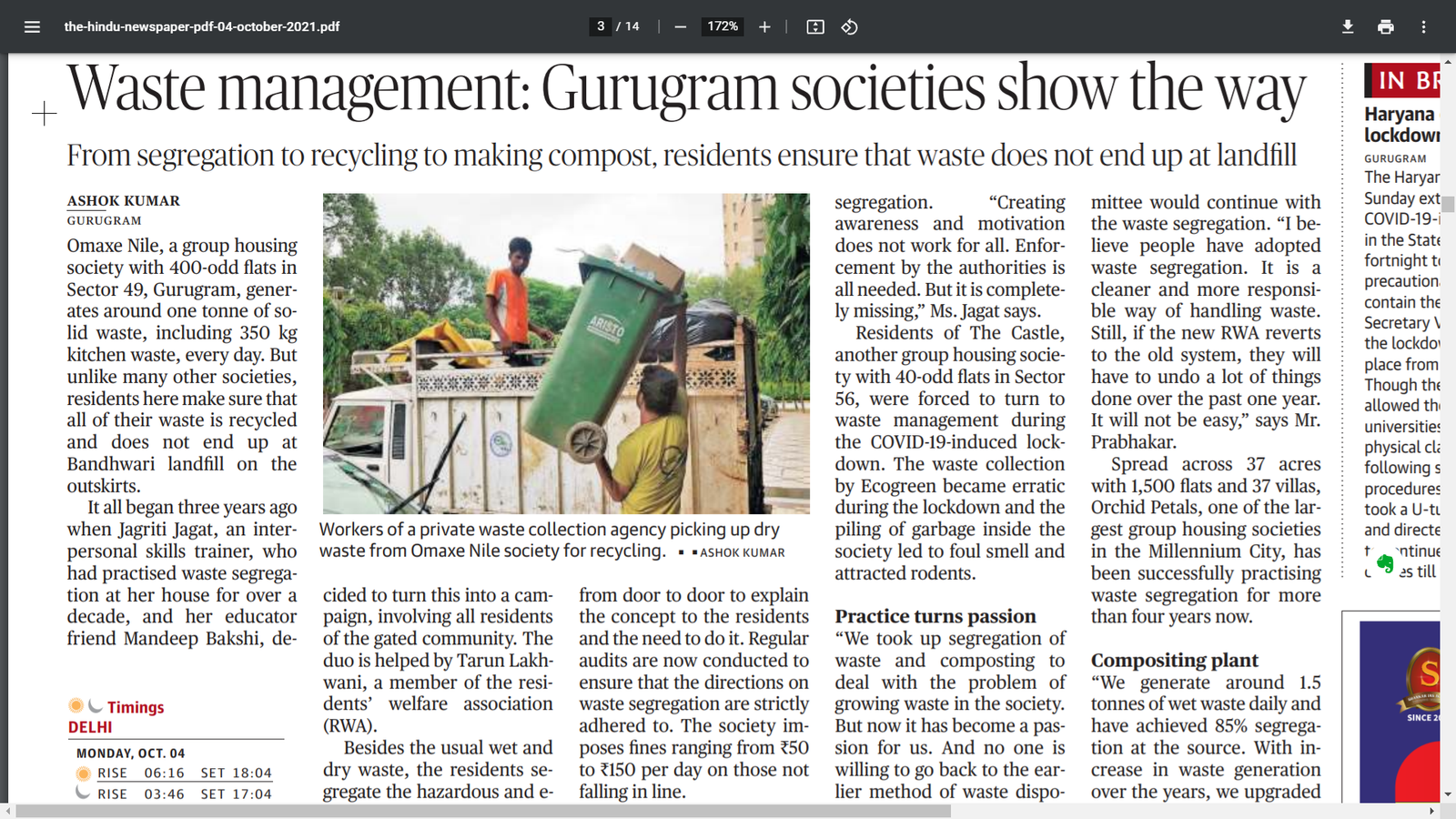
Prepare IAS Coaching
Current Affairs

Title : SOLID WASTE MANAGEMENT
Date : Feb 07, 2022
Description :
Based on an News Article published in the ‘The Hindu’
Useful for UPSC CSE Prelims and Mains (GS Paper III)
What is Solid Waste:
- Solid Waste Management Rules (SWM), 2016 defines solid waste as solid or semi-solid domestic waste, sanitary waste, commercial waste, institutional waste, catering and market waste and other non residential wastes, street sweepings, silt removed or collected from the surface drains, horticulture waste, agriculture and dairy waste, treated bio-medical waste excluding industrial waste, bio-medical waste and e-waste, battery waste, radio-active waste generated in the area under the local authorities and other entities mentioned in rule 2 ( i.e. urban local body, outgrowths in urban agglomerations, census towns as declared by the Registrar General and Census Commissioner of India, notified areas, notified industrial townships, areas under the control of Indian Railways, airports, airbases, Ports and harbours, defence establishments, special economic zones, State and Central government organisations, places of pilgrims, religious and historical importance as may be notified by respective State government from time to time and to every domestic, institutional, commercial and any other non residential solid waste generator situated in the areas).
Present Scenario of Solid Waste:
- Current global MSW generation levels are approximately 1.8 billion tonnes per year, and are expected to increase to approximately 2.2 billion tonnes per year by 2025.
- This represents a significant increase in per capita waste generation rates, from 1.2 to 1.42 kg per person per day in the next fifteen years.
- However, global averages are broad estimates only as rates vary considerably by region, country, city, and even within cities.
- According to MoEF&CC, 62 million tonnes of waste is generated annually in the country by the 377 million people living in urban India, the world’s third-largest garbage generator at present.
- Out of this, 5.6 million tonnes is plastic waste, 0.17 million tonnes is biomedical waste, hazardous waste generation is 7.90 million tonnes per annum and 15 lakh tonnes is e-waste.
- It is only about 75-80 per cent of the municipal waste gets collected and only 22-28 per cent of this waste is processed and treated.
- With rapid urbanisation, industrialisation and an explosion in population in India, solid waste management will be a key challenge for state governments and local municipal bodies in the 21st century.
Legislation in India for Solid Waste Management:
- Solid Waste Management Rules 2016:
- These rules replace the Municipal Solid Wastes (Management and Handling) Rules, 2000, are now applicable beyond municipal areas and have included urban agglomerations, census towns, notified industrial townships etc
- They focus on segregation of waste at source, responsibility on the manufacturer to dispose of sanitary and packaging wastes, user fees for collection, disposal and processing from the bulk generator.
- It has also been advised that the bio-degradable waste should be processed, treated and disposed of through composting or bio-methanation within the premises as far as possible and the residual waste shall be given to the waste collectors or agency as directed by the local authority.
- Solid Waste Management Rules 2016:
- The rules promote the use of compost, conversion of waste into energy, revision of parameters for landfills location and capacity
- The government has also constituted a Central Monitoring Committee under the chairmanship of Secretary, MoEF&CC to monitor the overall implementation of the rules.
- The Rules for the Safe Treatment of Legacy Waste prescribe bio-remediation and bio-mining in all open dumpsites and existing operational dumpsites in India.
- Apart from this, Article 51 A (g) of the Constitution of India makes it a fundamental duty of every citizen of India to protect and improve the natural environment including forests, lakes, rivers, and wildlife, and to have compassion for living creatures.
Issues associated with Solid Waste Management in India:
- No Storage of Waste at Source:
- There is absence of practice of storing the waste at source in a scientifically segregated way.
- Citizens have not been educated to keep domestic, trade, and institutional bins for storage of waste at source and stop littering on the streets.
- No System of Primary Collection from the Doorstep:
- There is absence of public system of primary collection from the source of waste generation.
- The waste discharged here and there is later collected by municipal sanitation workers through street sweeping, drain cleaning, etc.
- Street sweeping has, thus become the principal method of primary collection.
- Irregular Street Sweeping:
- Even street sweeping is not carried out on a day-to-day basis in most cities and towns in India.
- The tools used for street sweeping are generally inefficient and out-dated.
- Traditional handcarts/tricycles are used for collection, which do not synchronize with the secondary storage systems.
- Waste is deposited on the ground necessitating multiple handling.
- Transportation of Waste:
- Transportation of waste from the waste storage depots to the disposal site is done through a variety of vehicles such as bullock carts, three-wheelers, tractors, and trucks.
- A few cities use modern hydraulic vehicles as well. Most of the transport vehicles are old and open.
- They are usually loaded manually.
- The fleet is generally inadequate. Inefficient workshop facilities do not do much to support this old and rumbling squad of squalid vehicles.
- The traditional transportation system does not synchronize with the system of primary collection and secondary waste storage facilities and multiple manual handling of waste results.
- Processing of Waste:
- Generally no processing of municipal solid waste is done in the country.
- Only a few cities have been practising decentralized or centralized composting on a limited scale using aerobic or anaerobic systems of composting.
- In some towns un-segregated waste is put into the pits and allowed to decay for more than six months and the semi-decomposed material is sold out as compost.
- In some large cities aerobic compost plants of 100 MT to 700 MT capacities are set up but they are functioning much below installed capacity.
- A few towns are practising vermi-composting on a limited scale.
- Disposal of Waste:
- Disposal of waste is the most neglected area of SWM services and the current practices are grossly unscientific.
- Almost all municipal authorities deposit solid waste at a dump-yard situated within or outside the city haphazardly and do not bother to spread and cover the waste with inert material.
- These sites emanate foul smell and become breeding grounds for flies, rodent, and pests.
- Liquid seeping through the rotting organic waste called leachate pollutes underground water and poses a serious threat to health and environment.
- Landfill sites also release landfill gas with 50 to 60 per cent methane by volume.
- Methane is 21 times more potent than carbon dioxide aggravating problems related to global warming.
Way Forward:
- Laying down clear technical norms:
- It is important that Bio-mining and Bio-remediation is made compulsory for areas wherever it can be applied.
- It shouldn’t be left to the discretion of municipalities to decide whether there are geographical constraints that prevent the use of the aforementioned techniques.
- Biomining and Bioremediation are superior as well as simple methods which are not only cost-effective but also environment-friendly.
- The best part is that the land which was a landfill is fully available for alternate uses.
- Scientific Capping:
- Capping, if it is inevitable, should be done scientifically with underground pits that have a good bottom and sideliners, and proper piping and gas extraction systems to prevent the escape of leachate and gases.
- Decentralization of waste management:
- It is important that waste management is decentralized.
- Decentralization of waste management:
- Ambikapur in Chhattisgarh and Vellore present a very good example of the same where the waste was collected in a decentralized manner, composted naturally and is planted.
- A massive awareness campaign in association with communities, NGOs, students and other stakeholders needs to be planned to push for better implementation of these rules.
- The Rules need to focus on making solid waste management a people's movement by taking the issues, concerns and management of solid waste to citizens and grass-roots.
